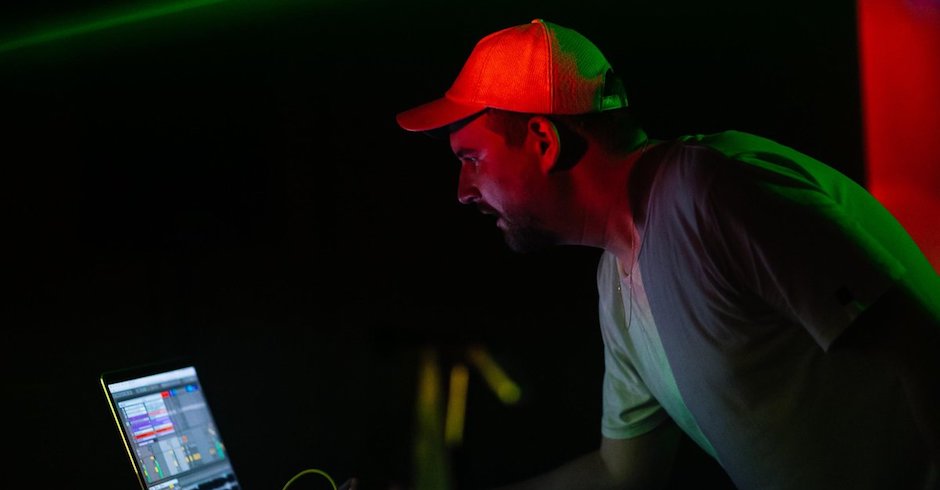 Interview: Celebrating Ten Years Of AkalaThe BAFTA Award winning hip hop and spoken artist is in Australia for a run of shows.
Interview: Celebrating Ten Years Of AkalaThe BAFTA Award winning hip hop and spoken artist is in Australia for a run of shows.

Machinedrum And The Journey To Human Energy
We chat to the American producer off the back of his latest album, Human Energy.
Header photo: Machinedrum playing at Sydney’s Civic Underground, taken by VOENA’s Sam Whiteside.
In electronic music, trends die quickly. The pioneering sounds of early synthesizers in commercial disco releases throughout the 1970s and 1980s are now few and far between, as are the slashing guitar riffs that blazed throughout electronic tracks in the 90s. Acid-house and fidget, both peaking in the mid-to-late 2000s, have too largely fallen into the same, dark pit of irrelevance. However, perhaps advantageously, the short attention span to sweeping trends and styles has also encouraged heavy experimentation and individuality between acts in a bid to stay ‘relevant’ as their signature genres that built their career early on now fall. One artist that knows this more than anyone is Machinedrum, the decade-spanning production alias of 34-year-old American Travis Stewart.
Whilst Stewart has never been the victim of a failing genre as such, a thorough search through his lengthy discography brings to light an immense number of varying sounds and wild experimentation within them, especially when you include his multitude of aliases beyond Machinedrum. 2001’s Now You Know and 2002’s Urban Biology, his two earliest albums under the Machinedrum pseudonym, delve into the clattering, Dilla-esque sounds of percussion-driven hip-hop instrumentals, a long step away from 2013’s acclaimed Vapor City – which saw Machinedrum distance himself from his glitch-hop roots in favour of the quick-paced footwork sounds of late pioneer DJ Rashad and DJ Spinn.
However, his biggest leap in musical experimentation was yet to come. Situated in the divide between glitchy electronic and full-blown pop music, Human Energy, his 2016 record released through Ninja Tune, is Machinedrum completely reinvented – something that Stewart says was brought on by experimenting with side projects when I caught up with him for coffee at Sydney’s bustling ivy complex. “I have a side project called Aden on Ultramajic [a record label founded by Jimmy Edgar, Pilar Zeta and Stewart himself], where I learnt some techniques like manipulating FM syntheses and operators in Ableton. I was able to bring these techniques into some of the more poppier tracks I was working on with singer-songwriters after Vapor City,” he details on the initial experimentation of sounds that lead to Human Energy’s distinctly different taste. “I was writing tracks in between shows but everything was still connected to Vapor City in a weird way. I really needed to start fresh”.
However, distancing himself from Vapor City and the success its largely-unexplored sounds brought was hard work. In the three years between Vapor City and Human Energy – years he says was largely filled with touring and writing tracks between shows – Machinedrum’s journey to what eventually became Human Energy had many attempts. “After writing all these tracks, I decided I really needed to start completely fresh on an album. I ditched around two albums worth of material for Human Energy,” he reflects. “I was kind of developing this new pop sound that wasn’t necessarily connected to Machinedrum, but more something that I was just experimenting with alongside vocalists. I just took all those things that I had learnt through these separate projects and applied them to my work as Machinedrum so I could develop the sound a bit more and grow out of that Vapor City style of music.”
The result, put out at the end of last year's particularly release-heavy September, shined. From the opening bells of Morphogene, to the triumphant, trumpeting breakdowns of Angel Speak and the sharp-pointed Dos Puertas, Human Energy’s glossy, brightly-shaded sound is almost career defining, earning Stewart more praise and respect than ever before. But where exactly did these sounds, which are so incredibly different to anything he’s ever released under his Machinedrum alias before, come from?
In addition to Machinedrum, Stewart has a large horde of side projects, many of which were rekindled in the time between Vapor City and Human Energy. Most recently there was Folding Time, the second album from his Sepalcure project and, perhaps more applicable when talking about the transformation into Human Energy, 2015 also saw the return of JETS – his project with good friend and fellow Ultramajic label head Jimmy Edgar. Having recently worked with bubble-gum pop pioneer SOPHIE, Edgar is someone that heavily influenced the creation of Human Energy – a possible reason to why the album is so distanced experimentally from Vapor City. “I would definitely say all my friends helped,” he says when discussing the influences behind Human Energy’s light and colourful sounds. “Like, I’m friends with Rustie. I’m friends with HudMo [Hudson Mohawke]. SOPHIE. I’m constantly influenced by what my friends are doing. I just try to make music that makes me happy and makes me smile.”
Amongst aural influences, his recent move to Los Angeles in 2015 is something that Stewart says helped with the creation of Human Energy, particularly with Los Angeles’ tendency to embrace the underground and experimental cultures in which artists like Machinedrum tend to strive and prosper. That, and with Los Angeles being such a hotspot for underground musical talent, Stewart had access to vocalists that would eventually become a pivotal part in the making of Human Energy. “There’s some newer people I’ve been collaborating with and getting closer to since I moved to Los Angeles - people like Rochelle Jordan,” he says, before continuing to talk about some of the collaborations behind Human Energy. “The record has a load of collaborations. People like MeLo-X [who has production credits on Beyoncé’s GRAMMY-nominated Lemonade] and Jesse Boykins III are people that I’ve known for years, so it’s cool to be able to work with those guys.”
One Human Energy collaborator that particularly stood out though was Dawn Richard, an American singer-songwriter who ended up featuring on one of the album’s stand-out singles – Do It 4 U. “She’s so inspiring, man. I was so lucky to have met her,” he boasts of Richard. “I think we both met each other at a point of our lives where we just kind of needed each other. Like I needed to find someone that was pro, super talented but also a little jaded and had already been through all the bullshit of the industry and wasn’t going to fuck around. I needed to work with someone that was going to get straight to business. Keep it honest. Keep it 100. Keep it like, super real - you know?” Do It 4 U isn’t the only track they’ve made together though. Her most recent album, last November's REDEMPTION, has nine tracks with production credits from Machinedrum. “We’ve been inspiring the hell out of each other,” he laughs. “We’ve probably made like, 25 songs together.”
Although his discography is littered with production credits and the odd collaboration under his Machinedrum alias, Human Energy is where Stewart took his collaborating efforts to the next level. Amongst the album’s fifteen tracks, Human Energy boasts collaborations with everyone, from the aforementioned Dawn Richard and MeLo-X to names including Ruckazoid, Kevin Hussein and Tosin Abasi, a Nigerian guitarist who features on one of the album’s stand-out tracks White Crown. “One conscious decision that I did make on this album was that I didn’t want to use samples,” he says when asked if leaning towards a more collaboration-heavy release was a purposeful move. “My past two albums have been very sample reliant, vocals too. Instead of using your typical house acapellas or 90s R&B acapellas like usual, I decided to go through all the past and new recordings I’ve done with friends and sort of take that sampling approach I’ve been using but apply it to the recorded vocals. Like for instance on Tell U with Rochelle [Jordan], she wrote a whole verse-chorus-verse thing and I took that acapella, took out little phrases and chopped them up like I would anything else. I did that on a few different tracks, just so I could y’know, keep it within the fam.”
The drive to become unique and fresh in the questionably over-saturated electronic music market is constant for Stewart, as displayed by the variation and growth within his musical lifetime. However, uniqueness in electronic music is so much more than just what you sound like in a recording session. A large part of what made Vapor City such an impressive record was its ability to be translated live. “I sort of had an audio-visual show for Vapor City but it wasn’t really a proper, live A/V show – more just pre-made visuals running in the background,” he says, talking about the creation of his well-known Vapor City stage show. “With the Human Energy tour I actually have a VJ performing with me, sometimes even on the stage with me if the venue can be set up right. We had this custom screen built that goes behind me as well as a scrim in front of me, so the light projects through the scrim onto the screen and creates this whole 3D feel. I basically wanted Strangeloop and Timeboy [who created the visuals for the Human Energy tour and have achievements including Flying Lotus’ famous Layer 3 stage-show under their name], to recreate the feeling of being hit by energy. That was the idea behind it anyway.”

Photo of Machinedrum playing at Sydney’s Civic Underground taken by VOENA’s Sam Whiteside.
This feeling of being hit by energy is also something relayed in the album’s artistic direction, something that saw Stewart reconnect with the Ultramajic team to create. The album’s cover art and teasing videos, which were placed on social media ahead of the album’s release, dazzle with sparkling light palettes that perfectly reflect the album’s vibrant feel. “I felt that Jimmy [Edgar] and Pilar [Zeta] are in line with a lot of the concepts for Human Energy and I felt that they were perfect to work with,” he explains, discussing working with Ultramajic for the album’s artistic direction. “Usually I work with Dom from LuckyMe for art direction but I don’t know, I just felt like I was really loving the work that Pilar and Jimmy had been doing over the past few years. They’re LA-based too, so we had been meeting and talking about the concepts behind the album which led to them pitching some artistic ideas that I thought were just so perfect. It made so much sense. Jimmy’s definitely influenced me on positive thinking and meditation and a lot of these concepts [that helped Stewart produce the album], so it just felt perfect to have them involved with it. I just made this giant mood board where I just collected these really freaky, esoteric and new-age gifs, videos and images online and sent it over to Jimmy and Pilar and kind of just let them do their thing. They really pay attention to their work.”
Moving on, the post Human Energy life has been somewhat hectic for Stewart, touring the album since just before its release aside from a short break to get married to his long-term partner, which he laughs about when I mention was an answer I had definitely had not heard before. Yet, the constant drive to create something new and exciting isn’t something he’s succumbing to anytime soon. “I’ve got two singles coming out on Ninja Tune soon. One with Rochelle Jordan again and another one with Rosie Lowe. I think they’re coming out early 2017,” he exclaims. “What I’ve learnt creating this album has opened me up to a whole new way of writing songs and I want to continue experimenting with that. I don’t think I’m in anyway finished exploring the direction I took with Human Energy but it has allowed me to get a bit more experimental with things, which is more or less my background from my earlier releases. I really want to experiment with that approach more and try to dig deeper into that sound.”
Follow Machinedrum: FACEBOOK / TWITTER / SOUNDCLOUD
 Interview: Celebrating Ten Years Of AkalaThe BAFTA Award winning hip hop and spoken artist is in Australia for a run of shows.
Interview: Celebrating Ten Years Of AkalaThe BAFTA Award winning hip hop and spoken artist is in Australia for a run of shows.
 Talking Shelter with Porter Robinson and MadeonAhead of their Australian tour, we talk to the guys about the project, the importance of a live show, and their future plans.
Talking Shelter with Porter Robinson and MadeonAhead of their Australian tour, we talk to the guys about the project, the importance of a live show, and their future plans.